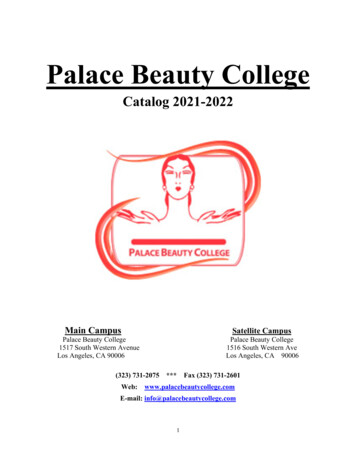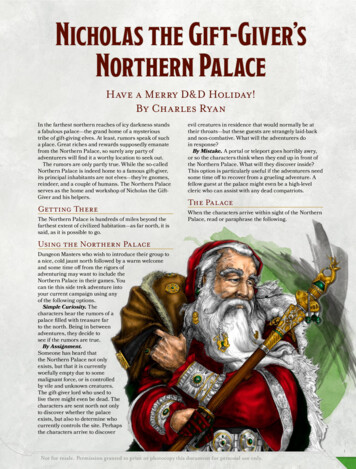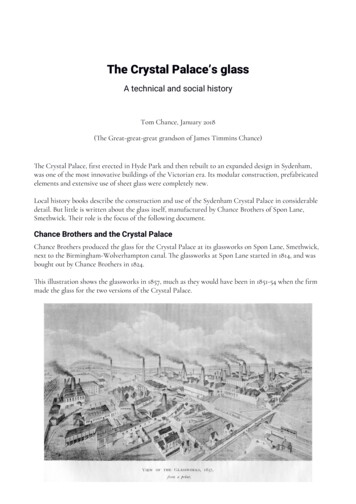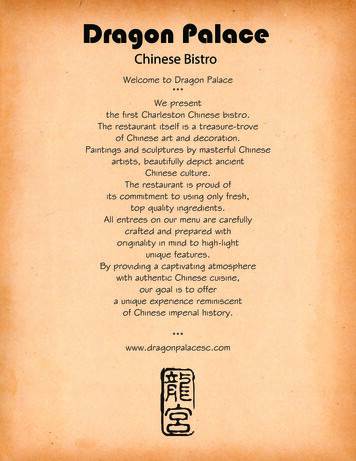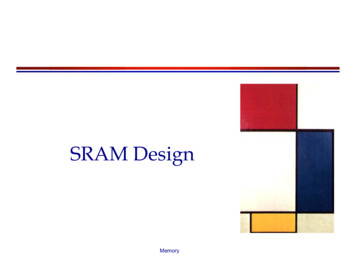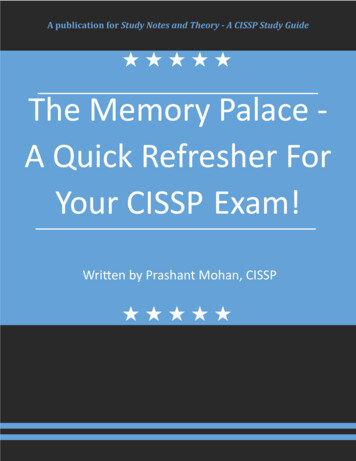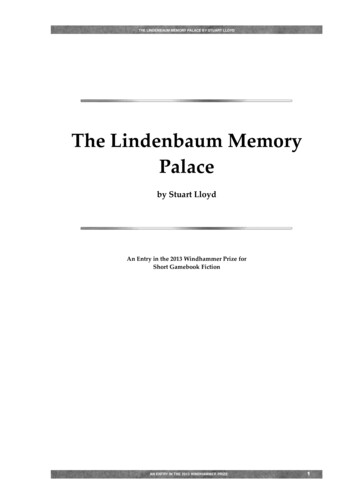
Transcription
THE LINDENBAUM MEMORY PALACE BY STUART LLOYDThe Lindenbaum MemoryPalaceby Stuart LloydAn Entry in the 2013 Windhammer Prize forShort Gamebook FictionAN ENTRY IN THE 2013 WINDHAMMER PRIZE1
THE LINDENBAUM MEMORY PALACE BY STUART LLOYDThe Lindenbaum Memory PalaceWarning! This is no normal book!Welcome to this gamebook! Yes, this is a gamebook, which means that it is full of numberedparagraphs. You do not read the paragraphs in numerical order. Instead, you need to read aparagraph before being given options of another paragraph to turn to. You then turn to thatnumbered paragraph before reading that to see which paragraph you turn to again and so on.Warning! This is no normal gamebook!This gamebook is here to educate as well as provide a challenge. There are references in thisgamebook which lead to websites that contain information that will help you with your challenge. Ifyou see a superscript number by a word like this0, then you will find the link at the back of this book.It is possible to continue without looking at the reference, but it may help you with the question youare on. The book is based on the idea of a memory palace1 which is a mnemonic device used toremember certain information. You can construct a memory palace by imagining yourself walkingaround a building (it does not have to be a palace) and wandering into rooms that contain items orpeople related to the information you are trying to remember. There are many examples of memorypalaces on the internet2. There are also plenty of places to get hints on building memory palaces3.In this gamebook, the memory palace has already been constructed for you, so it is down to you toexplore it in order to gain information and assess yourself on your knowledge. The LindenbaumMemory Palace has been built to help you revise how plants get their food.The aim of this bookThe aim of this book is to increase your understanding on how plants make their food. At the endof this book is a challenge where you can show off your new found knowledge on how plants maketheir food. You should take the challenge when you feel that you have obtained as muchunderstanding as you can. Getting answers right in the test lead to you winning multi-coloured gems.The number of gems you get on the test will demonstrate how much you have learnt. You shouldread through the book first, however, to see how much you know already. Then, if you identify someweak areas, you can read through the book again in order to refine your knowledge. When you havelearnt it all and answered all the questions correctly (you will know this when you have collected allthe gems and have no items, see below), give the test a go to see what score you get.RulesThe palace is laid out so that every room contains a concept to do with how plants get their food.When you first enter a room, you will be asked a question to do with that concept and you will have anumber of options to choose from. If you get it right, you will receive an explanation of why you areright (in case you were right for the wrong reason or if you just guessed, or even if you decided tocheat, you cheater!) and you will also be given a gem of a particular colour to indicate that you got thequestion right. If you are wrong, you will be told why you were wrong and given the correctexplanation. You will then be given an item to indicate that you need to revisit this concept.AN ENTRY IN THE 2013 WINDHAMMER PRIZE2
THE LINDENBAUM MEMORY PALACE BY STUART LLOYDItems and gemsThe only thing that you need to keep track of in the Lindenbaum Memory Palace is an inventorylist. This inventory is split into two sections, items and gems. You will receive a gem when youanswer a question correctly. This indicates that you are secure in your knowledge of that concept.If you answer a question incorrectly, you will receive something that is not a gem. It could beanything like a plank or a piece of metal. These things are items and they indicate that you have givenan incorrect answer to a question. This means that you need to revise it further.Your level of knowledge is higher when you have more gems and fewer items.Replaying the Lindenbaum Memory PalaceReplaying is encouraged until you can answer every question in the memory palace correctly (i.e.collect all the gems). For this reason, when you replay the Lindenbaum Memory Palace after the firsttime, you should retain the items and gems that you have obtained after previous play throughs toindicate your level of knowledge. You should then try to replay all the rooms that you obtained itemsin, so that you can get the gems from that room. If you get a gem from a room, you may also lose theitem that you would have obtained if you had answered a question incorrectly. This means that youcan show your progress by increasing the number of gems you have and decreasing the number ofitems you have. You know you are ready for the assessment when you are carrying all the gems youcould obtain and no items.Assess yourselfAt the end of the numbered sections is the Lindenbaum challenge which is an assessment whereyou can test your knowledge further. There is also a mark scheme where you get multi-coloured gemsfor your correct answers. The mark scheme cannot cover every possible wording of a correct answer,so you will have to use your own judgement in some cases, or maybe you could get someone else tomark it for you. Then you can see if there are any more concepts to revise further.Further resourcesThe back of the book contains a list of links to provide further information on how plants maketheir food. Use them in order to expand your knowledge.AN ENTRY IN THE 2013 WINDHAMMER PRIZE3
THE LINDENBAUM MEMORY PALACE BY STUART LLOYDCharacter sheetGems (tick off each gem when you get it)Blue gemWhite gemTurquoise gemRed gemGreen gemYellow gemPink gemPurple gemBlack gemNumber of multi-coloured gems (maximum 24)Items (tick off each item when you get it)Bottle of fizzy waterHelmetBlue celeryMagnifying glassSandwichWooden ballsBag of sweetsPiece of coralBalanceAN ENTRY IN THE 2013 WINDHAMMER PRIZE4
THE LINDENBAUM MEMORY PALACE BY STUART LLOYDYou are sitting at one of those desks that you used to have at school. There is a thick exam paper infront of you entitled ‘Plants and Photosynthesis exam’. You could have sworn that it was theelectricity and circuits exam today and spent all night revising circuit symbols and voltagecalculations. Beads of sweat start to form on your forehead and your hands start to tremble.The stern looking examiner at the front of the hall packed full of dedicated students in smart schooluniforms which contrast greatly with your reindeer jumper and announces ‘You have one hour tocomplete this exam, which contributes towards the course that will determine what you do for the restof your life. I must remind you that if you fail any exams in this course then you will be sentenced to alifetime of menial jobs that no one else will do, such as searching for odd socks, finding and disposingof out of date items from peoples’ fridges and clearing hair out sink traps. Good luck!’And with a Cheshire cat grin, the examiner presses his big round red nose which starts the hugeclock at the front of the hall ticking. You swear that the minute hand is moving as fast as a secondhand, but you have no time to think about that. As the rest of the students start scribbling theiranswers down at what seems like light speed, you frantically search your pockets for some kind ofpen. However, you pull out nothing but handfuls of fluff, buttons, pennies and sticky chewing gum.Half an hour has past already. As you leaf through the exam, desperately seeking any words thatlook vaguely familiar to you, you hear the music from Countdown4 play over the loud speakers. Eachtwang of the twangy instrument makes you more and more frantic. Your panic makes your teeth fallout of your mouth. The last one falls out just as the music stops.The examiner’s bow tie spins as he says ‘Put your pens down!’ The rest of the students all put theirpens down and start to organise the massive wads of papers on which they have all written hugetheses on the inner workings of a plant. The walks down the aisles, picking up each set of papers.You start to shake uncontrollably as he gets closer, thinking about how you have to explain to him,without the use of teeth, that you have written nothing.He comes to you. His red nose and purple hair are glowing in an angry fashion. You look up athim in pleadingly, but your attempt at sympathy only makes his eyes glow red.Then everything stops. Time stands still. You turn around and then see a sight that makes youjump.There is a dwarf standing right next to you. He is like one of those fantasy dwarves that you haveseen in Lord of the Rings if you are trying to be cool, or in Dungeons and Dragons manuals if you areallowed to be yourself. He is like most fantasy dwarves you have seen – short, big beard. dressed inchainmail armour and very grumpy looking. However, he carries no weapons and instead of ahelmet, he wears a fez.‘Knew it. Exam hall, no pen, time moving quickly. I could smell the anxiety miles away.’‘What are you talking about?’ You ask, confused.‘You’re dreaming, you twonk. Couldn’t you work that out by the time your teeth fell out? Thiscan’t be a real exam. There’s not even a hog roast.’‘So I don’t have a photosynthesis exam?’ You ask.‘Oh, you do. It’s in about three hours’ time. Which is where I come in. You see, against allexpectations, you have actually put a reasonable amount of effort into your revision whilst you werewatching re-runs of Friends and the information is hiding away somewhere in this head of yours. It’smy job to organise this information and make it memorable. Normally, your brain does this all in thebackground whilst you sleep, which is why it is good to get a full night’s rest before an exam, but youranxiety is off the charts so I’m going to be a little more overt with my help.‘Why are you I mean, did I make you look like.?’‘I am actually a dwarf, you know, not just a portion of your subconscious that has chosen this formbecause you like the look of it. And to answer your question, I’m not in any fantasy RPGs. Not mything really. I mean, they’re actually quite dangerous. Have you seen those spears? You could take aneye out with one of those. And those arrows are terrible. Do you know they don’t clean them? Youcould get tetanus if you got shot by one. It might just be a number to you, but we’ve got to take thebrunt of it. So I went to my boss, who gave me a job in education. Said I was good at getting downAN ENTRY IN THE 2013 WINDHAMMER PRIZE5
THE LINDENBAUM MEMORY PALACE BY STUART LLOYDthe kids’ levels or something. So here I am. Anyway, we’ve all got jobs to go to. Your seat is neededfor the next anxious student soon, so I’d better take you to the palace.’‘The palace?’‘Yes. The memory palace. Where we give form to all of your knowledge about photosynthesis. I’llexplain when we get there.’And with that, the dwarf clicks his fingers and there is a blinding flash of light.Turn to 1 AN ENTRY IN THE 2013 WINDHAMMER PRIZE6
THE LINDENBAUM MEMORY PALACE BY STUART LLOYD1You appear before a magnificent palace, made of pure white marble. Vines and ivy climb up thewalls. Behind them, you can see an elegant building with flying buttresses. You can see that a hugetree towers over the palace from the centre. . There are two large wide open wooden doors nearby.You turn to the dwarf.'So what is this place?''This is the Lindenbaum Palace. Inside is a whole load of information about how plants get theirfood.''And why is it a palace?''This thing was invented by the ancients to help them remember their speeches1. They figured outthat if you wanted to remember something, say for a test, then you would imagine yourself walkingthrough a palace. Each room of the palace would contain something that would help you remember achunk of information. The more ridiculous something is, the easier it is to remember. There is anexample here2.''Is that why you wear the fez?' You ask.'What are you trying to say about my fez? I think fezzes are cool.' Grumpily replies the dwarf 'Doyou want your help or not?''Sure. Anyway, what's your name?''I'm Steve. Nice to meet you.' He says as he shakes your hand.'OK Steve. Where shall we begin?'Without waiting for an answer, the dwarf walks off towards the gates. You follow him throughsome beautiful grounds, tended by various gardeners. Then you follow him through some corridors,past several ornate doors.If you have a blue gem and a white gem, turn to 6. Otherwise, read on.You wonder what is behind each one, but instead of going through the doors, he takes you to thesquare in the middle of the building. You wonder at the huge tree that towers over the both of you.Next to it, there is an old man, carrying a pot full of soil. In the pot is a young sapling.'This huge tree has grown bigger every year for many centuries, yet once it was tiny, like thissapling. Think about this question very carefully, for your instinctive answer may be wrong. Wherewill this sapling get the materials to one day become this mighty tree?'What is your answer?The soil? Turn to 39.Water? Turn to 4.The air? Turn to 37.2'I guess you said that because plants release oxygen gas and so that the left over elements are thatmake up glucose. Well, only some of the oxygen in the carbon dioxide and water is released as gas andsome becomes part of the glucose molecule. Carbon dioxide is made up of carbon and oxygen. Wateris made up of hydrogen and oxygen. Some of the oxygen is released from the leaf as oxygen gas andsome stays in the glucose molecule. It's glucose in my sweets that makes them taste sweet. Here havea bag.'The shopkeeper gives you a bag of sweets. Add the bag of sweets to your items list.Summary: Glucose is made up of carbon, hydrogen and oxygen.AN ENTRY IN THE 2013 WINDHAMMER PRIZE7
THE LINDENBAUM MEMORY PALACE BY STUART LLOYDAs you turn to leave, the kindly old shopkeeper calls out 'If you want to know more about theelements in glucose go through the door with the scales!'You thank the old man and leave. Turn to 10.3You walk through the door to find yourself in a large deserted canteen with several long tables.Steve is sitting one a chair with his feet up on the table whilst reading the latest issue of TheEconomist. Occasionally, he sips some coffee from a white mug with a cat on it. He then sees you anddrops the magazine.'Oh hello! Finished then? How did you do?'You tell him about your exploration.'That's great. Well, I have a challenge for you at the end of the book if you feel like you are ready.The more gems you have the more ready you will be. You could also retry your walk through thepalace again if you want. It should be shorter than the last one as if you have a gem for a room, thenyou won't have to repeat it. You just have to go through the rooms where you got an item or roomsthat you never entered. And if you get a gem, then you can get rid of the item that you got from theroom originally. Or you can leave the memory palace and take your test.'If you decide to go through the palace again, turn to 1.If you decide to take the challenge, turn to 42.If you decide to wake up and end your time in the memory palace, turn to 41.4'That is correct. This plant gets a lot of its mass from water, which it sucks up from the soil with itsroots.'Steve pulls a blue gem out of his pocket and gives it to you. 'That's for working it out.'Add the blue gem to your gems list. If you have a helmet, remove it from your items list.If you now have a blue gem and a white gem, turn to 35. Otherwise, Steve goes on.'However, there is another place that a plant gets its mass from as well as the water. Do you knowwhere that is?'The soil? Turn to 39.The air? Turn to 37.5'Correct!' Says Cicero 'all living things need oxygen to make energy which is used for movementand other things . It's called respiration.''Hang on,' Plants need oxygen, but so do all other living things and they don’t make their own, sohow can there be enough oxygen? There's loads of living things that just take in oxygen and don'tmake any themselves.''Good question5. Plants don't use all the glucose they make in respiration. Some of it is used to makethe substances that make up the plant. This means that plants give off about ten times more oxygenthan they take in, which is good for all of us creatures that can't use photosynthesis.''It certainly is!' Says Cicero 'And that means that I can go deep sea diving and have a look at thislovely coral reef down here. Last week, I found the wreck of a 17th Century Spanish treasure ship andwe helped ourselves to the treasure. Now we have more than we know what to do with.'AN ENTRY IN THE 2013 WINDHAMMER PRIZE8
THE LINDENBAUM MEMORY PALACE BY STUART LLOYDSummary: Plants release oxygen which is needed by all living things for a process calledrespiration, which is used to obtain energy for movement. However, whilst plants do respire anduse up some oxygen, some of the glucose is used to make new plant materials and so plants releasemore oxygen gas than they use up.Cicero flip flops over to a bench on the deck and picks up a purple gem and offers it to you. Add thepurple gem to your gems list. If you have a piece of coral, remove it from your items list.He then puts his headgear back on before Mike lowers him into the sea using the crane. You returnthrough the door and head back to the room. Turn to 10.6Steve leads you back to the room with several doors. 'You know all about where plants get theirfood, so you can start from here. I won't go into what to do. Come and find me when you're finished.'Steve then leaves you and heads through the fez door. You consider your options. Turn to 10.7'Correct! Chlorophyll is the green pigment in leaves that absorbs sunlight so that the plant canbreak down carbon dioxide and water. It can then use these substances to make glucose.'Phil then snaps his fingers and two pots of cress appear on the floor. One is looking green andhealthy, whilst the cress in the other pot is yellow and tall.'The yellow cress has no chlorophyll in it. Chlorophyll is a substance in a plant's leaf that makes itgreen. It is used to absorb sunlight which helps make glucose. The cress is taller because it has beensearching for the Sun.'Phil then snaps his fingers and a green gem appears, suspended in the air. 'Here you go. Enjoy it!'Add the green gem to your gems list. If you have a sandwich, cross it off your items list.Summary: chlorophyll is a green substance in a plant that absorbs sunlight so that its energy canbe used to break down carbon dioxide and water in order to make glucose.You return to the central room. Turn to 10.8The sweet shop owner shakes his head 'I'm afraid not. It's actually carbon, hydrogen and oxygen inglucose. People always get hydrogen and nitrogen mixed up. I think it’s something to do with themsounding similar. So there you are. Carbon dioxide is made up of carbon and oxygen. Water is madeup of hydrogen and oxygen. Some of the oxygen is released from the leaf as oxygen gas and somestays in the glucose molecule. It's glucose in my sweets that makes them taste sweet. Here have a bag.'The shopkeeper gives you a bag of sweets. Add the bag of sweets to your items list.Summary: Glucose is made up of carbon, hydrogen and oxygen.As you turn to leave, the kindly old shopkeeper calls out 'If you want to know more about theelements in glucose go through the door with the scales!'You thank the old man and leave. Turn to 10.AN ENTRY IN THE 2013 WINDHAMMER PRIZE9
THE LINDENBAUM MEMORY PALACE BY STUART LLOYD9You walk through the door and walk straight into a frantic melee of sizzling, chopping andshouting. You are in a restaurant kitchen. You walk amongst a gang of chefs chopping, frying andboiling. One chef is trying to cut a miniature chicken. You see the head chef shouting orders at hisbeleaguered assistants. He then sees you and stops what he is doing.'Good evening!' He shouts. 'I guess you want to know about chemical equations! Step this way!'You follow the head chef into his office which is full of cook books. 'So, you want to know aboutchemical equations, then?' He asks in a cheerful tone. ‘Well I’m Gordon Ramsbottom, and I don’t likeprofanity. Pleased to meet you!’'Yes please.' You say politely.'Well, there is not much to remember. Basically, a chemical equation is like a recipe. You have youringredients that you start with. In chemistry, we call these reactants. Then, you do something, such asadd heat and they turn into one or several new substances, which in chemistry, we call products. Forexample, if you get some flour, water and yeast, mix them up and stick them in an oven for a bit, youget bread.''And yummy bread indeed.' You add.'Thanks. It’s my own special recipe. Here, have some bread.’ Gordon offers you some bread whichyou take and stuff into your mouth. He then continues‘So if we wanted to write that like a chemical equation, we would write this:flour yeast water - bread.''What about the heat?''Well, we don't write that in. We only usually write in the actual substances, not what we do tothem.''And what's that thing with the arrow? Why not an equals sign?''Good question! Well an equals sign means that two things are the same. 1 1 2 means that 1 1 isthe same as 2. A mixture of flour, yeast and water is not the same as bread. Instead, it turns into bread.So the arrow means that a bunch of reactants turn into products.''Oh, I see.' You say, spitting out crumbs.'Exactly. So with photosynthesis, you start with carbon dioxide and water and you end up withglucose and oxygen, so the equation is carbon dioxide water - glucose oxygen.''That's great,' You say 'but if you've just told me the equation, what's your question going to beabout?''Well, I haven't gone into symbol equations yet. That's where the hard stuff starts. If you want agem, you are going to have to tackle symbol equations. Otherwise, you can leave now.'Summary: When you write an equation, you put the things you start with (the reactants) on theleft hand side, followed by an arrow and then the things you end up with (the products) on theright hand side i.e.Reactants - ProductsIf you would like to leave now, turn to 10.If you would like to try your hand at symbol equations, turn to 34.10You are back in front of the doors, each one leading you to a room where you can revise anotheraspect of photosynthesis. Or you could take the door with the fez symbol and leave this place. Whichone will you choose?AN ENTRY IN THE 2013 WINDHAMMER PRIZE10
THE LINDENBAUM MEMORY PALACE BY STUART LLOYDThe jug (water)? Turn to 23.The burning bush (carbon dioxide)? Turn to 11.The leaf (chlorophyll)? Turn to 32.The Sun (sunlight)? Turn to 31.The sugar cube (glucose)? Turn to 40.The wind (oxygen)? Turn to 24.The scales (equation for photosynthesis)? Turn to 9.The fez (exit)? Turn to 3.11You walk into a huge dome and feel lighter. You are surrounded by all kinds of trees and plants.Then you look up and see the dark sky of space.'Hullo.'You look around you to see a man in an astronaut's suit, but without the helmet.'Where am I?' You ask.'You're on the Moon, of course. I’m Neil Slaughter, the founder of the Moon colony. I thoughteveryone knew about this place.''Sure, sure I do. I was just expecting something else.''You're from that memory palace, aren't you? Well, it's 2062 and we're living on the Moon. Now Iknow why you're here, I'll tell you about how we can survive here. You see all of these plants?''Yes.''Well they keep us alive. You use oxygen for your body and you breathe out carbon dioxide. Well,plants use carbon dioxide for their photosynthesis and give out oxygen. We have a nice little cyclehere, but we need a lot of plants. We have four domes of plants and a dome containing phytoplanktonand we use a lot of electricity to keep the lights going, but we use helium-3 for that. Enough of that,though. Which part of the plant does carbon dioxide enter?'The leaf? Turn to 30.The root? Turn to 18.The stem? Turn to 33.12'Just the roots, huh? So you think the plant takes in water from the roots and then stores it there?Well, you're half right. Simon pulls another pot plant to reveal that its stem and leaves are also blue6.'You see, the water goes go through the roots, but then it also travels up the stem and then to theleaves. Every part of the plant needs water. Some of the water is used for photosynthesis and some isjust used to keep the plant upright.'Simon pulls another plant out from under the table. This plant is wilted and has a floppy stem.'A plant wilts when it doesn't get enough water because the cells that the plant is made up of needto be filled with water to be hard. If you fill a balloon with water, it feels quite solid. If you half fill aballoon with water, it is quite floppy. Plants are like that. Also, some water just flows from the roots, tothe stem, then the leaves and then out through the top of the plant. This is important as then morewater comes in through the roots to take its place. This whole process is called transpiration7.Summary: Water goes up through a plant's roots, through the stem and then to the leaves. Someof the water is used in photosynthesis to make glucose, some is used to keep the plant upright andsome just leaves through the top of the plant, but that helps keep the flow going.Simon gives you a stick of blue celery to remember him by. Add the blue celery to your items list. Hethen bids you farewell. You leave the room to try another door. Turn to 10.AN ENTRY IN THE 2013 WINDHAMMER PRIZE11
THE LINDENBAUM MEMORY PALACE BY STUART LLOYD13'So you think the plant uses the sunlight to grow bigger? It is true that plants can't grow withoutsunlight, but sunlight helps only a small, yet crucial part of the process. Let me show you.'Nina holds her hands out face up. On her hands appears what appears to be three wooden ballsheld together by strong. The middle on is black and the two on either side of it are red.'This is model of carbon dioxide. Plants need to break this molecule apart in order to use the partsto make glucose. Why don't you have go at breaking it up?'You take the model and try to pull the balls apart. Eventually, you break the string but it takes someeffort.'There you go. I bet if you did that a lot you would be hungry. You would need a lot of energy to doit. Well, the sunlight provides the energy to break the molecules up. Then the plant can use them tomake glucose and then the glucose is use for various things including helping the plant grow.''I see. Thanks for the help.' You say.Summary: Plants use the energy from sunlight to break up carbon dioxide and water so that itcan then use them to make glucose. This glucose is then used for several things including helpingthe plant grow.'No problem!' Says Nina cheerfully. she walks over to you and gives you a kiss on the cheek. 'Beforeyou go, take the model to remember me by.'Nina hands you the three wooden balls. Add the wooden balls to your items list.You then return to the main room. Turn to 10.14The dwarf leads you through another door. The room here is like a lab. There are several bencheshere covered in bottles, circuits and other apparatus. Inside this room is a man dressed as a priest. Heholds a burning candle in one hand and a plant in the other. Steve introduces you. 'This is josephPriestly, who was actually a member of the clergy, but did lots of other things besides.''Yes, I did!' Said Joseph. You notice that he has a stutter. I once trapped this plant in a glass jarwith a burning candle. I didn't know this at the time, but I now know that the burning candle used upall the oxygen gas in the jar produced a gas called carbon dioxide. This made it go out. However, Ileft this jar as it was and after a few weeks, I tried lighting the candle again. And it worked! The planthad taken all the carbon dioxide away and released more oxygen into the jar. And that's how weknow that plants need carbon dioxide.''Cheers, Joe!''Before you go, I've got a little present to remember me by. I used this carbon dioxide and put it inwater. This game me fizzy water. I hope you enjoy it!'Joseph Priestly grabs a glass bottle from a bench and offers it to you. You open it and try a bit. Ittastes very good. You never would have thought that there were fizzy drinks in the 18th century, butthere you go.Add the bottle of fizzy water to your items list.Summary: Plants do not get mass from soil. They get it from air and one other thing Steve the dwarf leads you back into the palace. You follow him as he rushes through the corridor,looking for another room.If you have no gems, turn to 21.If you have a blue gem, turn to 35.AN ENTRY IN THE 2013 WINDHAMMER PRIZE12
THE LINDENBAUM MEMORY PALACE BY STUART LLOYD15'Absolutely right. Every chemical reaction needs energy to get it started. The energy is used to breakthe molecules down, so that they can then be rebuilt differently. The sunlight is used to break downthe carbon dioxide and water so that they can be turned into glucose and oxygen. This is because thecarbon dioxide is made up of one carbon bonded to two oxygen atoms. The energy is needed to breakthose bonds.'Summary: Plants use the energy from sunlight to break up carbon dioxide and water so that itcan then use them to make glucose. This glucose is then used for several things including helpingthe plant grow.Nina walks up to you and gives you a kiss on the lips.'For being so clever, you can have this.' Nina presses a yellow gem into your hand. Add the yellowgem to your gems list. If you have wooden balls, cross them off your items list.You then return to the main room. Turn to 10.16'You've got the big numbers correct, but there should be small numbers in your equation. You haveto say how many atoms there are that are bonded together. This equation says that ther
The book is based on the idea of a memory palace 1 which is a mnemonic device used to remember certain information. You can construct a memory palace by imagining yourself walking around a building (it does not have to be a palace) and wandering into rooms that contain items or


